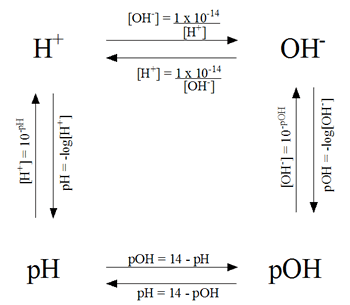 |
| http://www.sciencegeek.net/Chemistry/taters/Unit8pH.htm |
An example of a problem that would utilize this chart looks like this. The question regularly involves finding the equilibrium:
 |
| http://pinl.net/vs/ice-tables-for-equilibrium.xhtml |
In this problem, the I stands for INITIAL, which is the original information you are given. The C stand for CHANGE, which is +x, -x, -x most of the time across. Lastly the E is for EQUILIBRIUM. Once you place all of the components in the chart, you add them down. Next, you take those components and put them in the expression on the right, placing the products over the reactants in the solution (not including water) and equal that to the constant. Then, you distrubute the the costant to the fraction to come up with a quadratic formula. Next, with the formula, you place the parts of the formula to form a quadratic equation to find x. After you solve for x, you have the ion concentrations of either the acid or base you were looking for. Finally, if you wanted to find the pH or the pOH of the solution, you place the concentration in the antilog.
Here is a link to practice these types of questions and further explanations:
Explanation
Practice
This is a great post that is heavily detailed and I like how you place a practice in there as well. If I may suggest that next time you separate the paragraph into numbered steps so that it isn't all presented to the reader at once, but regardless, great post!
ReplyDeleteI really like this post Lilly! You did an excellent job explaining how to do the ICE problems and with a lot of detail. This post was very helpful in understanding the ICE Box problems!
ReplyDeleteGreat post Lilly, I thought you did a wonderful job going in depth to explain the ICE box problems. It helped me gain a better understanding on the topic.
ReplyDeleteLily, this post was great. I missed this day in class and the links and pictures you provided were very helpful.
ReplyDelete